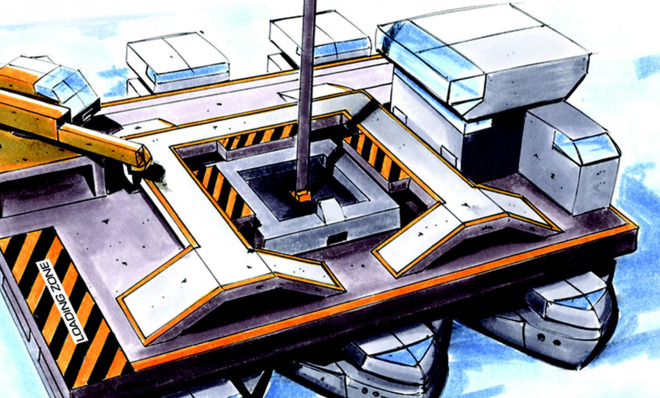To build the Death Star, we'll need this space elevator
Getting stuff into space cheaply will make it less of a frontier

Last year, I wrote about why we should make massive-scale space projects like Star Wars' Death Star a serious long-term goal for humanity. I wasn't joking.
OK, I was kind of joking — I chose the Death Star as my example because it was the biggest and most absurd-sounding space technology project that I thought readers would generally be aware of. But I could just as easily have chosen a Dyson sphere, or a ringworld, or a topopolis, or a faster-than-light spacecraft. Whether the project resulted in an energy source in space or a planet-destroying battle station didn't really matter for the purposes of my argument: The idea was that by reaching for the stars we could employ hundreds of thousands (millions?) of people during economic slumps and we'd accumulate a huge number of helpful technologies for use on Earth.
The good news is that we don't have to wait for super laser or tractor beam technology before we begin work. The first steps should be comparatively small R&D projects, such as sending a manned mission to Mars or building a permanent base on the Moon, which are well within reach. Or, as a new report from the International Academy of Astronautics (IAA) shows, we could begin by building a space elevator.
The Week
Escape your echo chamber. Get the facts behind the news, plus analysis from multiple perspectives.

Sign up for The Week's Free Newsletters
From our morning news briefing to a weekly Good News Newsletter, get the best of The Week delivered directly to your inbox.
From our morning news briefing to a weekly Good News Newsletter, get the best of The Week delivered directly to your inbox.
Lifting anything into space right now is really, really expensive. On the low side, it costs $4,300 per kilogram of weight for a Proton rocket launch, for example. On the high side, it can run $40,000 per kilogram of weight for a Pegasus rocket launch. That makes it hugely uneconomical to mine iron on Earth for the construction of large structures in space, just as it remains hugely uneconomical to mine asteroids in space and bring the resources back to Earth (something which — if we could do it cheaply — would hugely reduce the potential for resource shortages on Earth). At those costs, building anything in space is prohibitively expensive.
A space elevator — a huge fixed thread of carbon nanotubes stretching up thousands of miles into space, and held in place by a heavy anchor — could change that. The new report from the IAA suggests that the first generation "will be able to carry up to seven 20-ton payloads at once," Extreme Tech reports, and crucially "could bring the cost-per-kilogram of launch to geostationary orbit from $20,000 to as little as $500." Extreme Tech explains:
Not only is a geostationary orbit intrinsically useful for satellites, but it's far enough up the planet's gravity well to be able to use it in cheap, Earth-assisted launches. A mission to Mars might begin by pushing off near the top of the tether and using small rockets to move into a predictably unstable fall — one, two, three loops around the Earth and off we go with enough pep to cut huge fractions off the fuel budget. [Extreme Tech]
The main problem? The report notes that we don't yet have a material quite strong and flexible enough to build a space elevator. With current technologies, a 100km tether is possible, but that's nowhere near geostationary orbit, way up at 35,768km (22,236 miles).
"The IAA estimates that a pilot project could plausibly deliver packages to an altitude of 1000 kilometers (621 miles) as soon as 2025," Extreme Tech reports. We need to go for that, and push onto a space elevator up to geostationary orbit. Total costs are estimated at just $20 billion. This is a sensible complement to the $6 billion price tag of planning a mission to Mars, and $35 billion for building a base on the Moon. That sounds like a lot, but next to the $750 billion price tag for bailing out the banks in 2008, or the $4 trillion dollar price tag of the wars in Iraq and Afghanistan, it's just a drop in the bucket.
A free daily email with the biggest news stories of the day – and the best features from TheWeek.com
There is a really pressing practical reason that humanity needs to reach for the stars. Our civilization sits in dangerous territory. There are over seven billion of us, yet we are all concentrated on one ecosystem — the Earth, with one tiny totally dependent off-planet colony, the International Space Station, which houses less than 10 people at a time. A single mass viral pandemic, asteroid strike, or other cataclysm could completely wipe our species out. With humanity spread throughout the solar system — and preferably, the galaxy and the universe — our species is far less fragile to random extinction events. This is a challenge that must be addressed, and a few extra billion dollars a year is a small price to pay to secure humanity's future.
With interest rates on government borrowing still very, very cheap, the private sector is almost begging the government to borrow and invest by offering it such cheap money. The only thing holding us back is a lack of ambition.
Editor's note: This article has been revised since it was first published in order to more clearly include proper attribution to source material.
John Aziz is the economics and business correspondent at TheWeek.com. He is also an associate editor at Pieria.co.uk. Previously his work has appeared on Business Insider, Zero Hedge, and Noahpinion.
-
 A foodie guide to Edinburgh
A foodie guide to EdinburghThe Week Recommends Go all-out with a Michelin-starred meal or grab a casual bite in the Scottish capital
-
 Political cartoons for December 24
Political cartoons for December 24Cartoons Wednesday's political cartoons include Christmas in Greenland, grinchflation, and California floods
-
 Is there a Christmas truce in the Starmer farmer ding-dong?
Is there a Christmas truce in the Starmer farmer ding-dong?Today’s Big Question There’s an ‘early present’ for farmers but tensions between Labour and rural communities remain